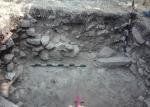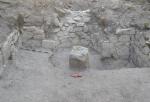Summary (English)
A wider project focused on the Paeonian culture along the Bregalnica River, in 2017 included the investigation of the Gradishte – Peshtera site in the Kiselica village near Delchevo. After an initial survey, a hillfort was identified on a high plateau on the left bank of the Kiselica River (right above the Kiselica Cave), tentatively dated to the Late Antiquity. Small-scale excavations were planned at two locations, aiming to give more precise chronology and to check for earlier remains below what is visible at the surface. The first location was inside the thick oak forest, where a pile of stones and the outline of a structure was visible – a location locally known as St. Dimitrie (Demetrios). The excavations revealed the remains of a small church with a semi-circular apse at its eastern end, measuring 7,35×5,40 m in total. The walls, in places preserved up to 1 m height, were built using worked stones and marl mortar. An entrance was found in its western wall, and sone elements of the interior. The apse area was violated by illegal excavations. Following the stratigraphy in a small trench in the SE corner of the building, it was established during the Early Christian times, and was twice renewed – once towards the end of the 6th century, and again at some point during the Medieval period.
In a small test trench near the western edge of the plateau a layer of rubble was found, covering the remains of a structure of which a stone-and-mud wall, a doorstep and a beaten clay floor were discovered. Within the rubble a silver Roman coin from the 1st century BC was found, and some metal and ceramic items on the floor level, together with some animal bones. The building, as well as the earliest phase of the church (without suggesting synchronicity), were built directly on the bedrock.
The excavations at the two locations revealed a long continuity of habitations on the plateau, at least from the 1st century BC fortified settlement, until the end of the existence of the church, which, according to some of the finds and the collective memory of the local people, it lasted well into the Medieval period.
Director
- Darko Stojanovski
- Trajce Nacev - Goce Delchev University, Shtip






![Download [PDF]](/excavation/skins/fasti/images/results/download_sml.png)
